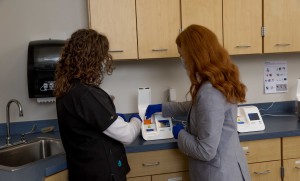The ability to conduct research as an undergraduate student was one of the items that drew Laura Dirks ’17 to South Dakota State University. Born in Brookings, she moved to Buffalo, Minnesota, as a youth and stayed there until it was time to return to Brookings for college.
After graduating in December 2017 with majors in both chemistry and biochemistry, she headed to the Rollins School of Public Health at Emory University in Atlanta. Dirks earned a Master of Public Health in global health. Her studies included a concentration in infectious disease.
During her time at Emory, Dirks served as a One Health practicum student at the Centers for Disease Control and Prevention where she supported COVID-19 zoonotic response efforts, in addition to serving in a support role for the development and implementation of CDC zoonotic disease workshops throughout the world.
She was also a graduate research assistant for Emory’s Center for the Health of Incarcerated Persons, where she managed and supported various research projects and research-related activities. This led Dirks to her thesis work, which focused on using technology to support tuberculosis treatment of persons currently incarcerated in Haiti’s jails and prisons.
 All of that knowledge came in handy when she returned to SDSU in June 2020 to serve as the public health specialist amid SDSU’s ongoing COVID-19 mitigation.
All of that knowledge came in handy when she returned to SDSU in June 2020 to serve as the public health specialist amid SDSU’s ongoing COVID-19 mitigation.
As an alumna, her familiarity with the campus and student life provided an advantage when developing and implementing plans for campus operations throughout the pandemic. Dirks likes the challenges presented by the pandemic as each day provides a new challenge or opportunity based on information provided by the scientific community or the CDC.Â
“The public health guidance is constantly changing. Most of what I do is take all of the new information, apply it and balance it with what we have to do as a campus,†she said.
 Dirks said there were many things, such as asymptomatic transmission and cleaning or disinfection of surfaces, the scientific community and CDC did not know about COVID-19 because of its newness. And then there was the impact made by human behavior.
Dirks said there were many things, such as asymptomatic transmission and cleaning or disinfection of surfaces, the scientific community and CDC did not know about COVID-19 because of its newness. And then there was the impact made by human behavior.
“From a professional standpoint, there are always certain things that people push against and that’s public health, but I think that it was a larger challenge for this pandemic,†she said. “Part of that was because the guidance changed as we learned more about the virus. The effectiveness of masks and the impact of asymptomatic transmission were important mitigation measures that we didn’t know about in the very beginning. I think if you were able to see the full timeline of the pandemic, it’d be easier to get everyone on the same page, but we just didn’t know what that looked like.â€
Despite wide availability of vaccinations and infection rates slowing, Dirks is still very busy.
“What I’m working on right now is how we as a university can be resilient,†she said. “We have to take what we learned and what we did to be successful and be ready if there’s a future outbreak.â€
– Matt Schmidt






